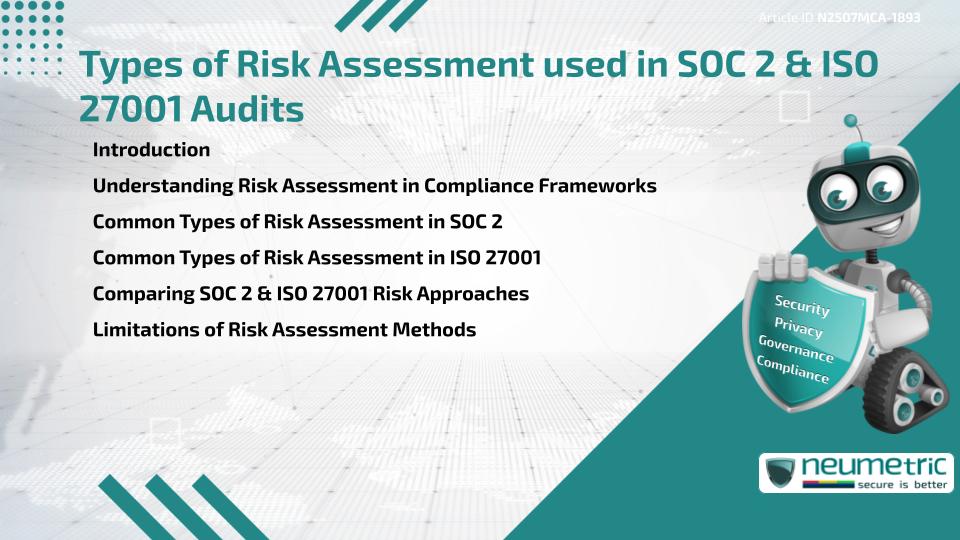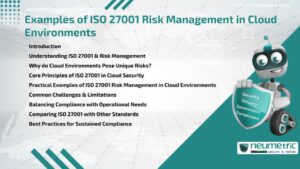Table of Contents
ToggleIntroduction
The Types of Risk Assessment used in SOC 2 & ISO 27001 Audits play a crucial role in determining how Organisations identify, evaluate & manage Risks to their Data & Systems. These Audits help Businesses align with Industry Standards for Security, Availability, Integrity & Confidentiality. While both Frameworks share a goal of effective Risk Management, they adopt different Risk Assessment approaches. This Article explores the Key Types of Risk Assessment used in each Standard & How they differ.
Understanding Risk Assessment in Compliance Frameworks
Risk Assessment is the structured Process of identifying Threats, analyzing Vulnerabilities & Evaluating the Likelihood & Impact of potential Events. In the context of SOC 2 & ISO 27001, it ensures that Control measures are appropriate & proportionate. This step is foundational in both Audits, acting as a guide for implementing effective Security Controls.
Common Types of Risk Assessment in SOC 2
SOC 2, based on the Trust Services Criteria developed by the AICPA, is more flexible & typically driven by Client-specific requirements. The most common Types of Risk Assessment used in SOC 2 include:
- Qualitative Risk Assessment: Focuses on the subjective Likelihood & Impact of Risks, often using scales such as Low, Medium or High.
- Control-based Risk Assessment: Maps existing Controls to identified Risks to evaluate effectiveness & residual Risk.
- Gap-based Assessment: Identifies missing Controls by comparing the current Security Posture with the desired state.
SOC 2 Assessments are often less prescriptive & depend heavily on the Auditor’s judgment & the service Organisation’s Business Environment.
Common Types of Risk Assessment in ISO 27001
ISO 27001 is more structured & internationally recognized. It mandates a formal & recurring Risk Assessment process. The main Types of Risk Assessment under ISO 27001 include:
- Asset-Based Risk Assessment: Starts by identifying Information Assets & Assessing Threats to them.
- Likelihood-impact Matrix: Evaluates Risks by assigning numerical values to Likelihood & Impact, leading to a Risk score.
- Control Objective Assessment: Aligns Risks with Annex A Control objectives to determine necessary Actions.
The ISO.org guidelines expect documented Results & Repeatable methodology.
Comparing SOC 2 & ISO 27001 Risk Approaches
While both Frameworks use similar tools, ISO 27001 requires formal documentation & ongoing updates. SOC 2 offers more flexibility but also demands that decisions be justifiable to Auditors. ISO 27001 is typically favored for International Operations, whereas SOC 2 is common in North America.
Limitations of Risk Assessment Methods
No method is perfect. Qualitative approaches may lack consistency, while quantitative ones often rely on incomplete Data. Overreliance on Checklists may also ignore contextual Risks. It’s essential to combine multiple methods for a Holistic view.
Takeaways
- The Types of Risk Assessment vary significantly between SOC 2 & ISO 27001.
- SOC 2 prefers flexible, Qualitative methods suited to specific Business needs.
- ISO 27001 mandates structured, Asset-focused Assessments.
- Understanding both enhances Compliance Readiness & Security Posture.
FAQ
What is the purpose of Risk Assessment in SOC 2 & ISO 27001 Audits?
Risk Assessment helps identify, evaluate & manage Potential Threats to Systems & Data, forming the basis for choosing appropriate Security Controls.
How does Qualitative Risk Assessment differ from Quantitative Methods?
Qualitative Methods use descriptive Terms to rate Risk, while Quantitative methods assign Numerical Values to assess Risk severity.
Is ISO 27001 stricter than SOC 2 in Risk Assessment?
Yes. ISO 27001 requires a formal, documented process, while SOC 2 allows for more flexibility based on organizational context.
Can one use the same Risk Assessment for both Audits?
Not effectively. Each Audit has unique requirements & expectations, making separate Assessments more suitable.
How often should Risk Assessments be updated?
At least Annually or when there are significant changes in Systems, Processes or Threat Landscapes.
References
- ISO/IEC 27001 Information Security Standard
- AICPA Trust Services Criteria
- NIST Guide to Risk Assessments
- IT Governance ISO 27001 Risk Assessment Guide
- ISACA Risk IT Framework
Need help for Security, Privacy, Governance & VAPT?
Neumetric provides organisations the necessary help to achieve their CyberSecurity, Compliance, Governance, Privacy, Certifications & Pentesting needs.
Organisations & Businesses, specifically those which provide SaaS & AI Solutions in the Fintech, BFSI & other regulated sectors, usually need a CyberSecurity Partner for meeting & maintaining the ongoing Security & Privacy needs & requirements of their Enterprise Clients & Privacy conscious Customers.
SOC 2, ISO 27001, ISO 42001, NIST, HIPAA, HECVAT, EU GDPR are some of the Frameworks that are served by Fusion – a SaaS, multimodular, multitenant, centralised, automated, CyberSecurity & Compliance Management System.
Neumetric also provides Expert Services for technical Security which covers VAPT for Web Applications, APIs, iOS & Android Mobile Apps, Security Testing for AWS & other Cloud Environments & Cloud Infrastructure & other similar scopes.
Reach out to us by Email or filling out the Contact Form…





